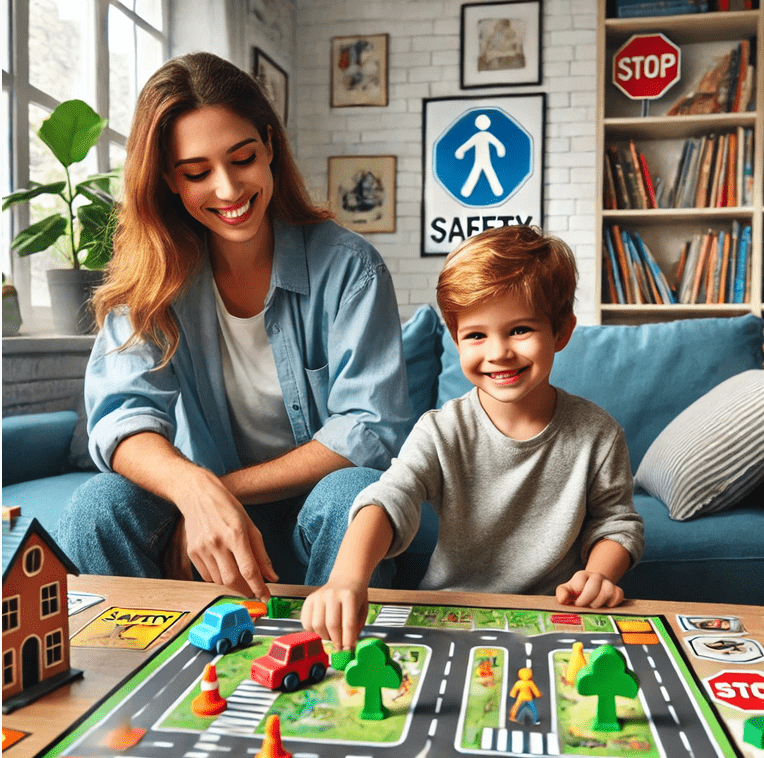Teaching kids about personal safety is essential, but it doesn’t have to be boring or scary.
By turning safety lessons into fun and interactive activities, children are more likely to understand and remember the rules that keep them safe. Here are five creative and engaging ways to help kids learn about personal safety while having fun!

1. Role-Playing Safety Scenarios
Children love role-playing because it allows them to act out different situations and practice what they’ve learned in a safe and controlled environment. You can use role-playing to teach various personal safety lessons, such as:
- Stranger Danger: Act out scenarios where a stranger approaches and offers a gift or asks the child to follow them. Teach them to say “No” firmly, run away, and tell a trusted adult.
- Emergency Situations: Practice what to do in case of a fire, earthquake, or other emergencies. Show kids how to “Stop, Drop, and Roll” in case of fire, or how to safely exit the house.
- Safe vs. Unsafe Touches: In a sensitive yet important discussion, role-play different situations to teach children the difference between appropriate and inappropriate touch, and encourage them to speak up if they feel uncomfortable.
How It Helps: Kids learn best by doing, and role-playing allows them to practice personal safety responses, making them feel more confident if they ever face a real situation.
2. Safety Games and Quizzes
Turning safety lessons into games makes learning more enjoyable for kids. You can use fun quizzes, board games, or even mobile apps designed to teach personal safety topics. Some ideas include:
- Safety Bingo: Create a bingo card filled with safety rules like “Look both ways before crossing,” “Wear a helmet when biking,” or “Stay near an adult in public places.” As you go through the lessons, kids can mark off the corresponding squares on their bingo card.
- Safety Charades: Write different safety scenarios (e.g., “Stop, Drop, and Roll,” “Finding a safe adult,” or “Crossing the street”) on slips of paper, and have children act them out while the others guess.
- Online Safety Quizzes: Use kid-friendly apps or online quizzes that cover topics like road safety, internet safety, or first aid.
How It Helps: Games encourage active participation and help reinforce key safety lessons in a playful way, keeping kids engaged and interested.
3. Create a Safety Scavenger Hunt
A scavenger hunt is a great way to teach kids about identifying safe and unsafe items or environments. You can do this indoors, in your backyard, or even at a park. Some ideas for a safety-themed scavenger hunt include:
- Finding and identifying safety equipment, like fire extinguishers, first aid kits, or smoke alarms.
- Spotting potential hazards, such as sharp objects, electrical outlets, or items that can cause tripping.
- Locating safe places, like a parent or teacher, and places to avoid, such as the street or a body of water without supervision.
You can even add a twist by incorporating clues about what to do when they find each safety item or hazard, teaching them practical responses along the way.
How It Helps: Scavenger hunts tap into kids’ natural curiosity while training them to recognize both safety tools and potential dangers in their surroundings.
4. Safety-Themed Crafts
Get creative by incorporating personal safety lessons into craft activities. Children can make visual reminders of safety rules or create their own safety gear. Some craft ideas include:
- Safety Posters: Have children design posters with catchy safety slogans like “Always Look Both Ways,” “Don’t Talk to Strangers,” or “Buckle Up Every Time.” Hang them in their rooms or shared spaces as daily reminders.
- DIY First Aid Kit: Let children help assemble a mini first aid kit by decorating a small box or container and filling it with band-aids, gauze, and hand sanitizer. Teach them what each item is for and how to use it safely.
- Custom Safety Gear: Help kids decorate their helmets, knee pads, or reflective vests, turning safety gear into something fun to wear.
How It Helps: Craft activities are hands-on and creative, allowing kids to internalize safety lessons while expressing themselves artistically.
5. Storytelling and Books
Children love stories, and using books to teach personal safety can be both fun and educational. There are many age-appropriate books that cover topics like stranger danger, fire safety, and hygiene. Some classic examples include:
- “The Berenstain Bears Learn About Strangers” by Stan and Jan Berenstain – This story introduces the concept of stranger danger in a way that is easy for young children to understand.
- “Officer Buckle and Gloria” by Peggy Rathmann – A humorous story that teaches the importance of following safety rules.
- “It’s My Body” by Lory Freeman – A gentle introduction to personal boundaries and safety.
You can also create your own stories or have the children come up with their own. Ask them to imagine what they would do in a dangerous situation, and let them tell the story of how they stayed safe.
How It Helps: Storytelling helps children understand complex safety concepts in a relatable and engaging way. Books and stories often make lasting impressions, which can help reinforce safety messages over time.
Conclusion
Teaching kids about personal safety doesn’t have to be daunting or dull. With creative approaches like role-playing, games, scavenger hunts, and storytelling, children can learn essential safety skills in a way that is fun and memorable. By using these methods, you’re not just teaching them to follow rules—you’re empowering them to be confident and prepared to handle various situations safely.
Bonus Tip for Parents and Educators: Reinforce these lessons regularly and make them a part of daily life. Safety is a continuous learning process, and by keeping it fun, kids will be more engaged and retain the important information that could help keep them safe.

No comments yet